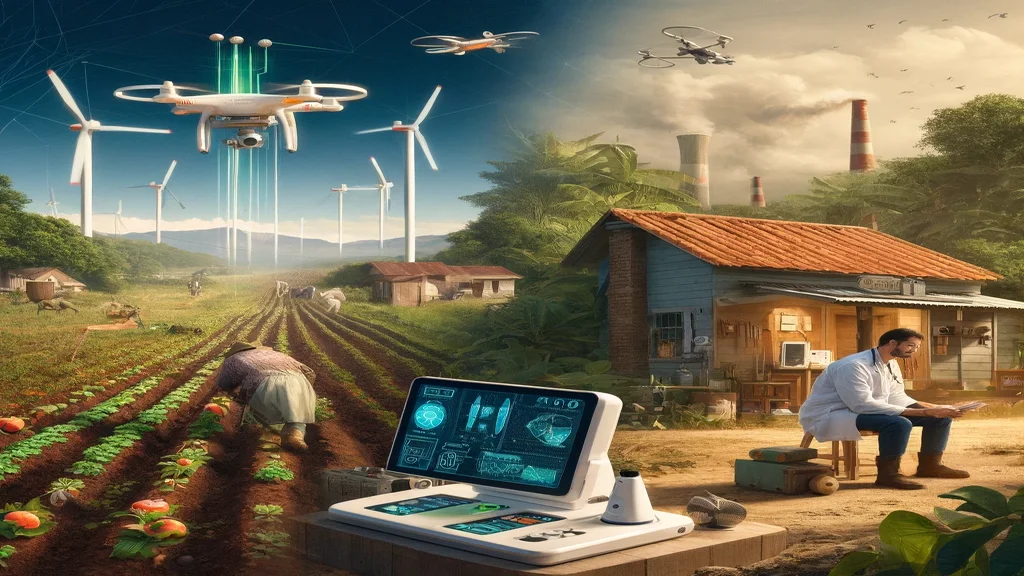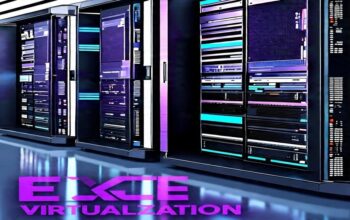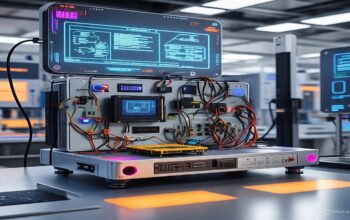Covered Contents
ToggleIntroduction: Why Edge AI Is Important in Rural Regions
Imagine a farmer in rural Kenya who needs to identify agricultural diseases immediately. Or a doctor diagnosing patients in the Amazon without internet access. Low-connectivity locations are where cloud-based AI fails. The gap is filled by edge AI. Edge AI offers intelligent solutions that are not dependent on the cloud by processing data locally on devices (such as phones, sensors, or drones). This article explores how Edge AI enables innovation where it is most needed by transforming offline processing in places with poor connections.
What is Edge AI?
Edge AI combines artificial intelligence (AI) and edge computing to enable smart decisions to be made right on the devices. Data transmission to distant cloud servers is no longer necessary. Edge AI runs data locally on devices like smartphones, sensors, or drones, eliminating the need to travel back to faraway data centers like other systems do.
A cell phone, for example, can open using facial recognition technology without requiring the downloading of any photographs to the cloud. Similarly, a weather sensor at a distance may predict storms instantly using algorithms on the device itself.
The Challenge of Low Connectivity
Fast Internet connectivity is uncommon in the majority of rural areas, including farms, mines, hospitals, and communities. 2.6 billion people worldwide, 96% of whom reside in developing countries, are thought to lack internet connectivity. Slow data transfer, erratic networks, and higher prices for satellite-based internet services are some of the issues brought on by the resulting digital divide. Because data transfer to distant computers is expensive and time-consuming, these issues make cloud-hosted AI solutions unaffordable. By enabling local data processing on devices, reducing reliance on cloud services, and increasing productivity in places with poor connectivity, Edge AI addresses these problems.
How Edge AI Works Offline
Fast Internet connectivity is uncommon in the majority of rural areas, including farms, mines, hospitals, and communities. 2.6 billion people worldwide, 96% of whom reside in developing countries, are thought to lack internet connectivity. Slow data transfer, erratic networks, and higher prices for satellite-based internet services are some of the issues brought on by the resulting digital divide. Because data transfer to distant computers is expensive and time-consuming, these issues make cloud-hosted AI solutions unaffordable. By enabling local data processing on devices, reducing reliance on cloud services, and increasing productivity in places with poor connectivity, Edge AI addresses these problems.
Applications of Edge AI in Low-Connectivity Zones
Agriculture: Cloud-Free Intelligent Farming
Soil sensors track the amount of moisture and nutrients in the soil and recommend watering.
-Drones using Edge AI are used for harvest planning, pest detection, and land mapping.
Real-World Example: Farmers in India who used Edge AI saw a 30% rise in yields (FAO, 2022).
Medical Care: Preserving Lives Abroad
In distant clinics, portable ultrasound machines are used to diagnose pregnancy issues.
Malaria is detected in blood samples by AI-powered microscopes.
Impact: A 25% reduction in Ghana’s maternal death rate (WHO, 2023).
Energy:
– Wind farms and offshore rigs Monitoring Edge AI prevents costly downtime by anticipating equipment failures at offshore rigs.
-Solar grids use local weather data to enhance energy delivery.
Disaster Response: Using AI in Emergency Situations
– Drones with thermal cameras locate survivors in earthquake-hit areas.
– Offline language translation aids rescue teams in isolated regions.
Benefits of Edge AI in Offline Environments
Reduced Latency: It may take a few seconds for cloud AI to respond. In less than 100 milliseconds, Edge AI reacts. For emergency alerting or self-driving tractors, that speed is crucial.
Reduced Costs: There is no need to pay for pricey satellite internet. For example, fishermen on Lake Victoria in Kenya use Edge AI for weather reports, which lowers their monthly bill by $200.
Better Privacy: Private data, including financial or medical information, isn’t sent to servers run by third parties. This upholds laws like the GDPR of the EU.
Low Power Consumption: Devices like the NVIDIA Jetson Nano use only 10 to 15 watts of power. It is appropriate for solar-powered systems because of its low energy consumption.
Edge AI is a good choice for most applications because of these advantages.
Overcoming Edge AI Challenges
Edge AI is not flawless. Here’s how pioneers are addressing limitations:
Limited Hardware Power
Solution: Creating ultra-light AI models with TinyML (Tiny Machine Learning) maximizes performance on hardware with low processing resources. For example, Google’s Coral Edge TPU is developed to execute efficient AI models on edge devices, enabling quick data processing without overwhelming hardware resources.
Lack of Data
Solution: The lack of real-world data is addressed by using techniques for creating synthetic data. For example, in agricultural settings, AI models are trained offline using artificially created photos of crop illnesses in order to diagnose diseases accurately without the need for extensive real-world information.
Maintenance in Harsh Environments
Solution: Robustly built devices ensure reliable operation in harsh environments. Companies like Siemens have created robust edge computing solutions that are ideal for industrial settings where dependability is crucial. These solutions are resistant to dust, moisture, and extremes in temperature.
With the help of these solutions, Edge AI keeps getting better, producing reliable and efficient technologies suitable for a wide range of applications even when they are utilized in harsh environments.
Future Trends: What’s Next for Edge AI?
Future Trends: What Will Be the Next Development in Edge AI?
Edge AI + 5G Hybrids: combining sporadic cloud updates with local processing.
AI-Chips in Consumer Devices: Edge AI will be integrated into phones, refrigerators, and cars.
Decentralized AI networks: There is no central server; instead, devices share insights.
According to Gartner, Edge AI will be used in 80% of industrial IoT devices by 2030.
How to Implement Edge AI in Your Projects
Choose the right hardware, such as the Raspberry Pi, NVIDIA Jetson, or Qualcomm Cloud AI 100.
Enhance AI Models: Use programs like TensorFlow Lite or ONNX to shrink the model size.
Test under Actual Circumstances: Assume bad connectivity just to be safe.
Pro Tip: Start small. Less than $50 for a solar-powered soil sensor that will pay for itself in a few months.
Conclusion: Edge AI is Democratizing Technology
Edge AI is not only a technological trend—it’s a lifeline for billions. On farms and in hospitals, it closes the gap between high-tech potential and low-connectivity reality. As hardware becomes more affordable and AI models more intelligent, offline processing will open up new opportunities for the “unconnected” world.
Final Thought: The future of AI isn’t in the cloud. It’s at the edge—where it’s needed most.



Need a way to get millions of people to engage with your website on a budget? For Details: http://zab658.blastmillions.top